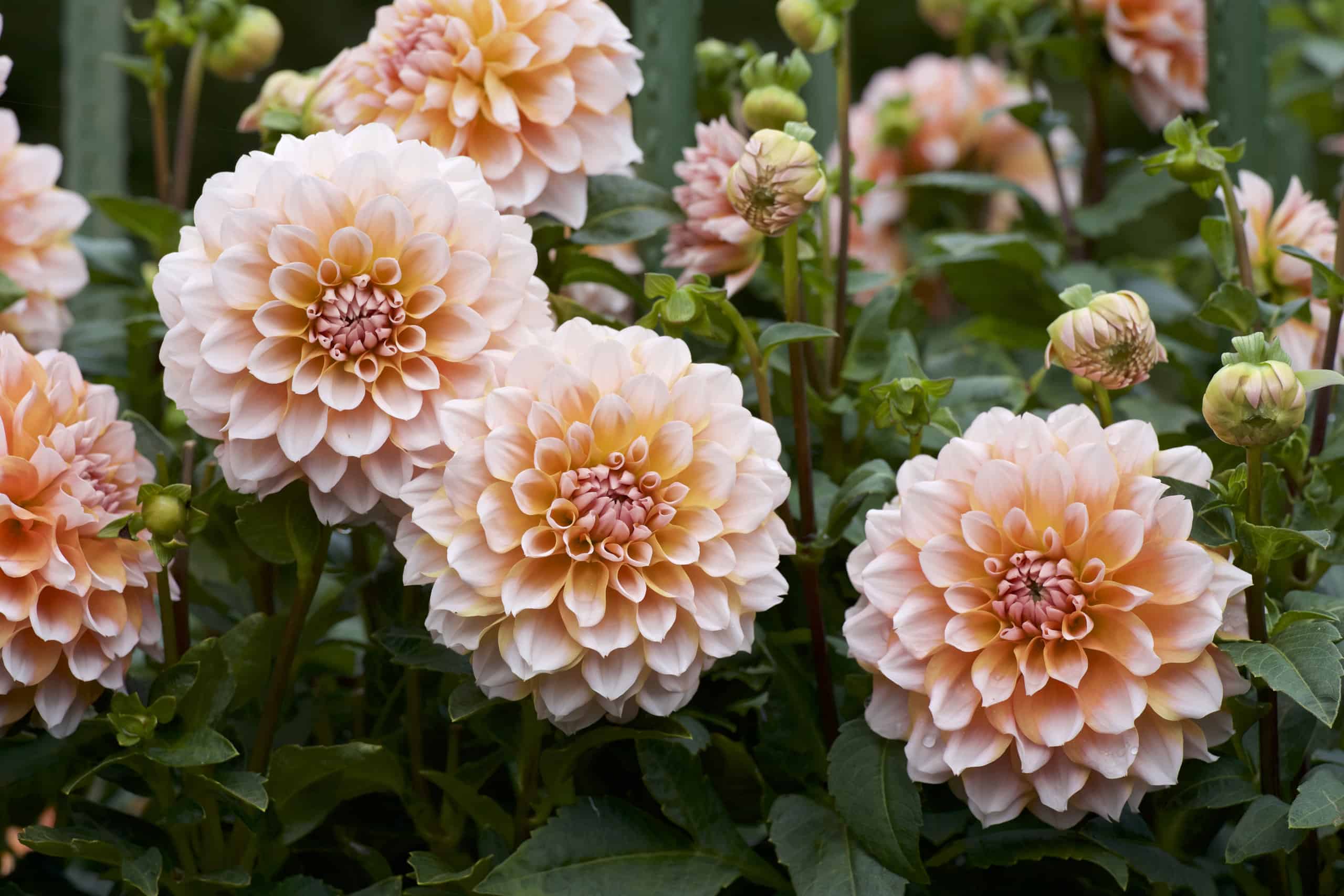When we think of flowers blooming, spring or summer usually springs to mind. But as the air turns crisp and leaves start to fall, a variety of vibrant autumn flowers get their moment in the spotlight. There are many fall flowers for an amazing autumn bloom.
From fiery hues to unique floral formations, these flowers contribute a fascinating diversity to the world’s landscapes. Each of these autumn blooms hails from different corners of the globe. And each has a unique story to tell, from its native roots to its preferred habitat and blooming period. Moreover, this captivating ensemble of fall flowers proves that the gardening season continues long after the end of summer, bringing joy, color, and life to gardens and outdoor spaces everywhere.
Let’s embark on a journey to discover the beauty and charm of these autumn wonders.
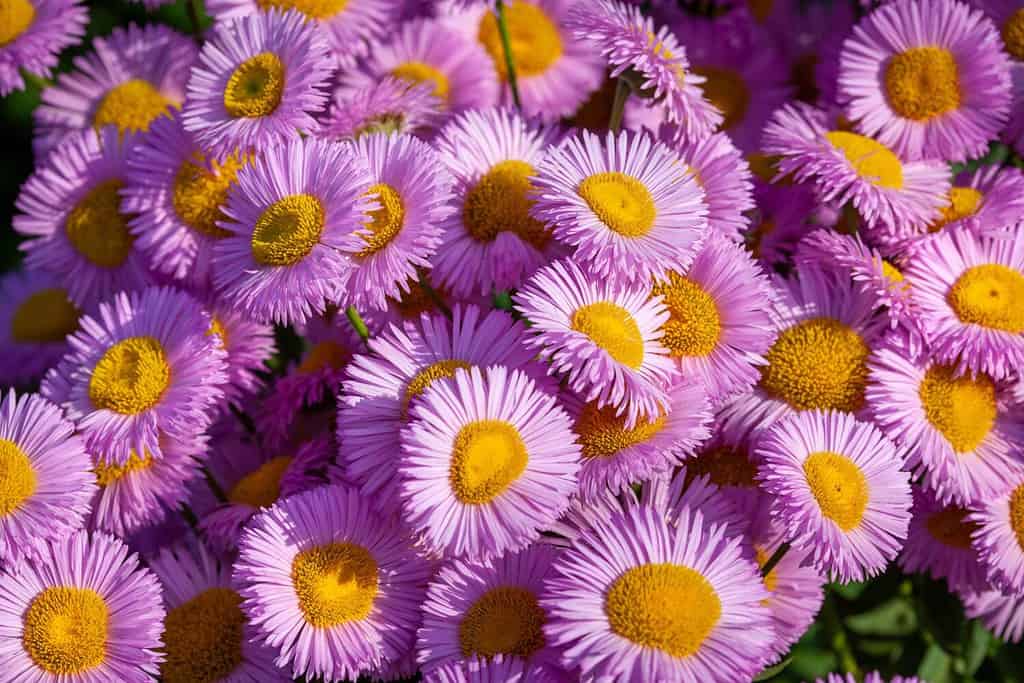
Asters are a popular fall flower to encounter in the Northern Hemisphere.
©Klever_ok/Shutterstock.com
1. Aster
The Aster is a charming autumn flower, unfurling its daisy-like blooms from late summer through fall. This plant is native to the Northern Hemisphere. It thus thrives in temperate climates, delighting gardeners with a lengthy display that often extends until the first frost. Aster’s distinctive features include its vibrant blue, purple, or white hues and attractive golden center that draws in butterflies. Not only a feast for the eyes, but aster’s resilience also shines through its ability to grow in sunny and partially shaded areas, offering a delightful note of versatility to any garden.
2. Chrysanthemum
Flourishing best in full sunlight and well-drained soil, the Chrysanthemum or ‘mum’ adds a burst of autumnal hues to landscapes and gardens, primarily in the northern hemisphere. Mums come alive in the early fall and offer a vivid display through late autumn, sometimes until the first frost. Furthermore, they have a spherical form and boast a spectacular palette of red, orange, yellow, pink, and white.
3. Goldenrod
Known for its showy plumes of bright yellow flowers, Goldenrod thrives in full sun to light shade areas across North America. In addition, it makes its grand appearance in late summer and continues to bloom into the fall. These plants serve as an essential late-season resource for pollinators and offer a vibrant yellow spectacle during the fall season.
4. Japanese Anemone
With its graceful pink or white flowers, the Japanese Anemone is a beautiful sight in the fall. Moreover, it is native to Japan, as the name suggests, and it does well in partial shade and prefers moist soil. Blooming from August to October, the plant features delicate petals and a whimsical appearance that can add a touch of elegance to any autumn landscape.
5. Stonecrop (Sedum)
Sedums are incredibly versatile and Indigenous to the Northern Hemisphere but extend into the southern continent of Africa. They grow in a wide range of conditions but prefer full sun and well-drained soil. Their star-shaped flowers bloom in clusters atop succulent foliage from late summer into fall. Furthermore, the flowers range from white and pink to red and yellow, depending on their variety.
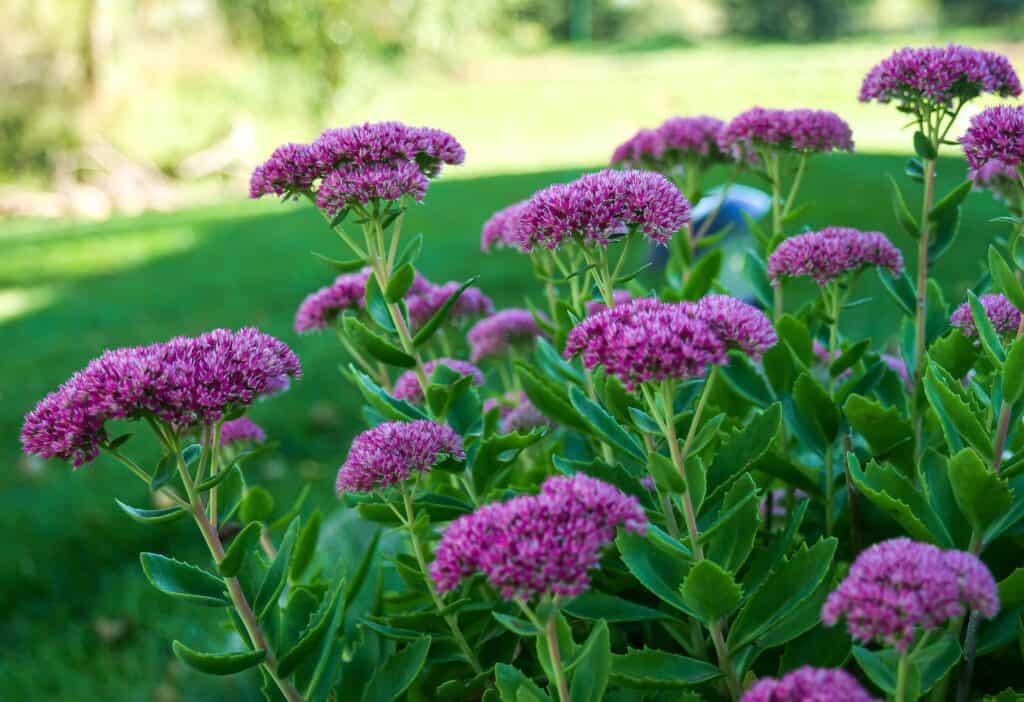
Stonecrop range from white and pink to red and yellow.
©Edgar Lee Espe/Shutterstock.com
6. Coneflower
Coneflower, or Echinacea, flourishes in well-drained soil and full sun across North America. It begins blooming in mid-summer and continues until the frost. Moreover, the flower comes in an array of colors from bright pink and white to yellow and stands out with its large, prominent cone at the center of daisy-like petals.
7. Russian Sage
Preferring sunny locations and well-drained soil, Russian Sage is a sturdy plant native to central Asia. Furthermore, its spires of tiny lavender-blue flowers bloom from mid-summer into the fall, creating a haze of color that contrasts beautifully with the silvery foliage.
8. Joe-Pye Weed
This native North American plant loves sunny or partially shaded wetlands. Moreover, it blooms from late summer into fall, with beautiful clusters of pink-purple flowers that attract pollinators, offering a splash of color to the fading fall landscape.
9. Toad Lily
Toad lilies are native to Eastern Asia. Preferring shady locations, the Toad Lily is known for its unique orchid-like flowers. Blooming in late summer and fall, this plant delivers an exquisite display of purple-spotted white flowers that add a unique charm to the autumn shade garden.
10. Dahlia
Proudly native to Mexico, the Dahlia is a gardener’s delight that flourishes in well-drained soil and abundant sunlight. In addition, this robust, tuberous perennial makes its glorious appearance from mid-summer to the first frost, providing a vibrant, long-lasting display. Furthermore, Dahlias boast an impressive range of large flowers that come in a variety of forms, from the simplicity of single, daisy-like blooms to the complex beauty of double forms. Their color palette is equally diverse, making them a spectacular addition to any garden.
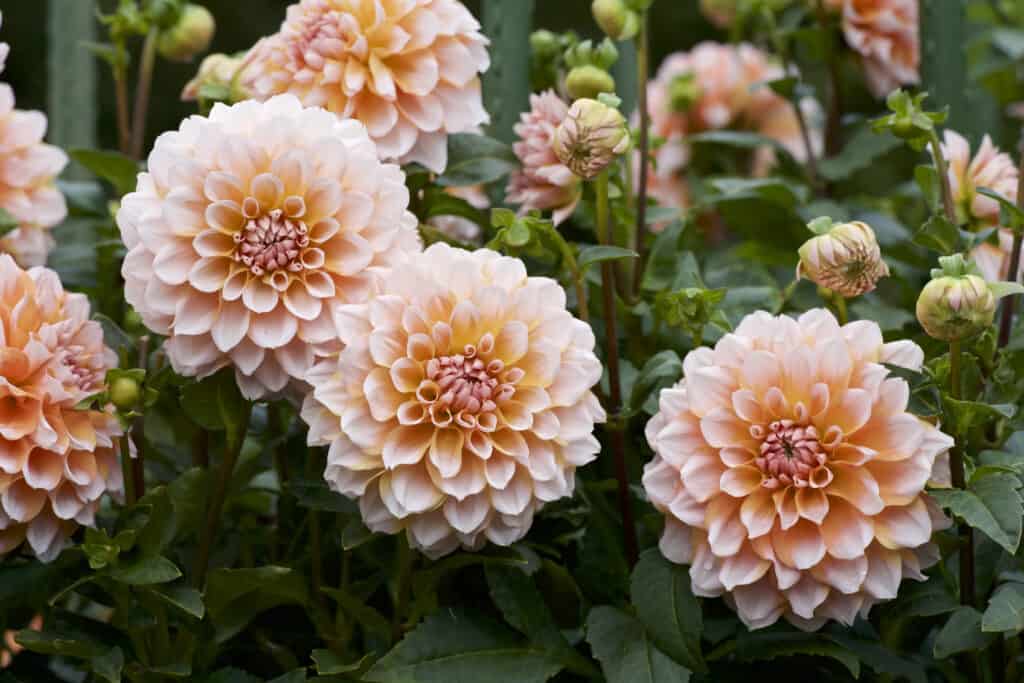
Dahlias are tuberous perennials.
©iStock.com/Billy_Fam
11. Nerine
Hailing from the diverse landscapes of South Africa, Nerines are perfectly suited for well-drained soil bathed in full sun. These autumn-blooming bulbs offer a brilliant display from September to November. In addition, they are renowned for their lily-like flowers, which burst into life in bright pink hues. This late-season eruption of color adds a unique charm to the garden, making Nerines a delightful choice for those looking to extend the blooming season.
12. Autumn Crocus
The Autumn Crocus, or meadow saffron, is native to the Mediterranean regions of Southern Europe. It thrives in well-drained soil and can tolerate sunny and partially shaded locations. This late bloomer displays its beautiful pink-purple flowers from September to October. Despite its beauty, caution should be exercised around the autumn crocus as all parts of the plant are poisonous if ingested.
13. Monkshood
Monkshood, originating from mountainous regions in the Northern Hemisphere, finds its comfort zone in moist, well-drained soils under full sun or partial shade. Moreover, the plant owes its name to the unique blue-purple, hood-like flowers it displays. This late bloomer provides a refreshing color highlight from late summer to early fall. However, it’s essential to note that all parts of the Monkshood plant are poisonous if ingested.
14. Canna Lily
The Canna Lily is a tropical native that prefers locations with full sun and rich, moist soil. Hailing from the tropical regions of the Americas, this plant is known for its showy, gladiolus-like flowers. Its striking blooms and dramatic foliage present a bold statement in the garden from late spring until frost.
15. Tickseed
The Tickseed, also known as Coreopsis, is a cheerful addition to any garden. Native to North America and South America, these plants are happiest in full sun and well-drained soil. From early summer to fall, they bloom into daisy-like flowers available in various colors, including yellow, red, pink, and white.
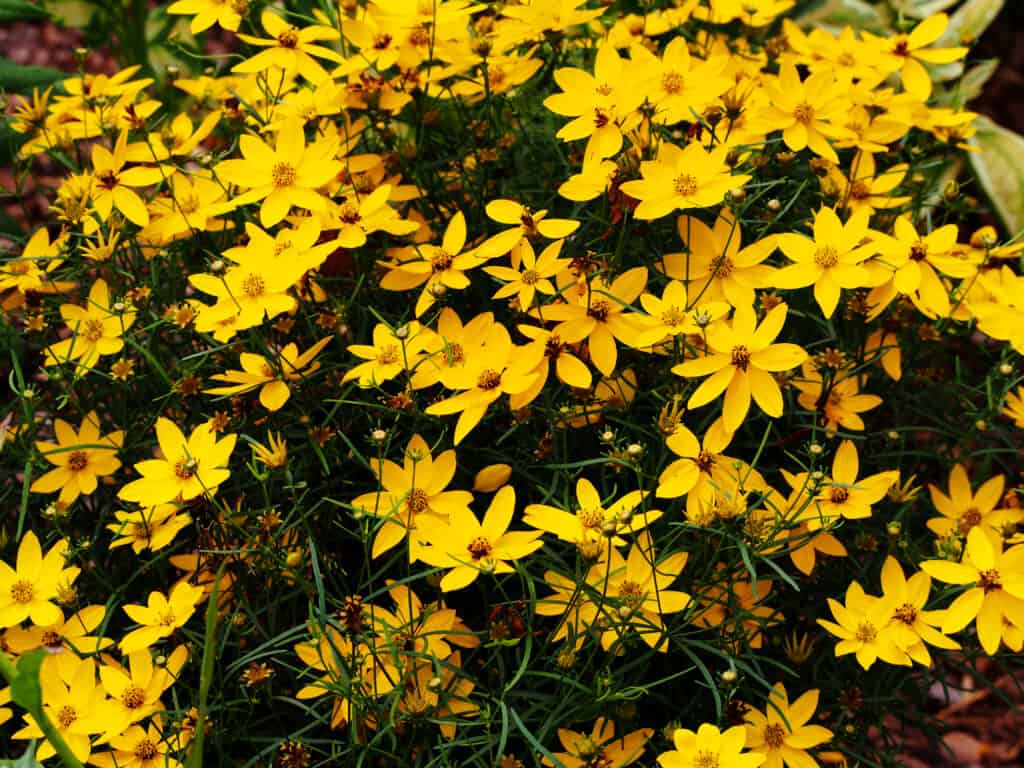
Tickseed comes in various colors, including yellow, red, pink, and white.
©iStock.com/Gratysanna
16. New England Aster
The New England Aster is a vibrant native of North America. It thrives in moist, well-drained soil and loves basking in the sun. From late summer to early fall, it bursts into a vivid display of large, purple flowers that are a magnet for butterflies, adding color and life to the garden.
17. Black-Eyed Susan
Known for its bright, yellow, daisy-like flowers with a dark brown center, the Black-Eyed Susan is native to North America. It flourishes in areas with full sun and well-drained soil. The plant puts on a show from mid-summer to fall, offering a long-lasting, cheerful display of color.
18. Helenium
Helenium thrives in full sun and well-drained soil, embracing its North American roots. From mid-summer to autumn, it showcases a spectacle of daisy-like blooms in warm hues of yellow, orange, and red. Characterized by drooping petals and raised center cones, Helenium brings a touch of the sun to any garden. Finally, its common name, sneezeweed, comes from the old practice of using its dried leaves to make snuff.
19. Colchicum
Native to West Asia and parts of the Mediterranean, Colchicum prefers well-drained soil and locations with full sun to partial shade. These autumn crocuses burst into bloom from September to October. Their large, goblet-shaped, pink-purple flowers are a sight to behold, especially since they appear without their leaves. This trait has earned them the name “naked ladies.”
20. Mountain Fleece
This spectacular plant originates from China and the Himalayas. It thrives in full sun or partial shade with moisture-retentive soil. From mid-summer to autumn, tiny, tubular pink flower spires form impressive, dense spikes. Moreover, the beautiful contrast between its dark leaves and bright blooms makes Mountain Fleece a striking feature in any garden.
21. Sunflower
A quintessential North American native, Sunflowers grow best in full sun and well-drained soil. These towering beauties bloom from summer into fall, their large, yellow, daisy-like flowers always turning to face the sun. Finally, this fascinating behavior, known as heliotropism, gives the Sunflower its name.
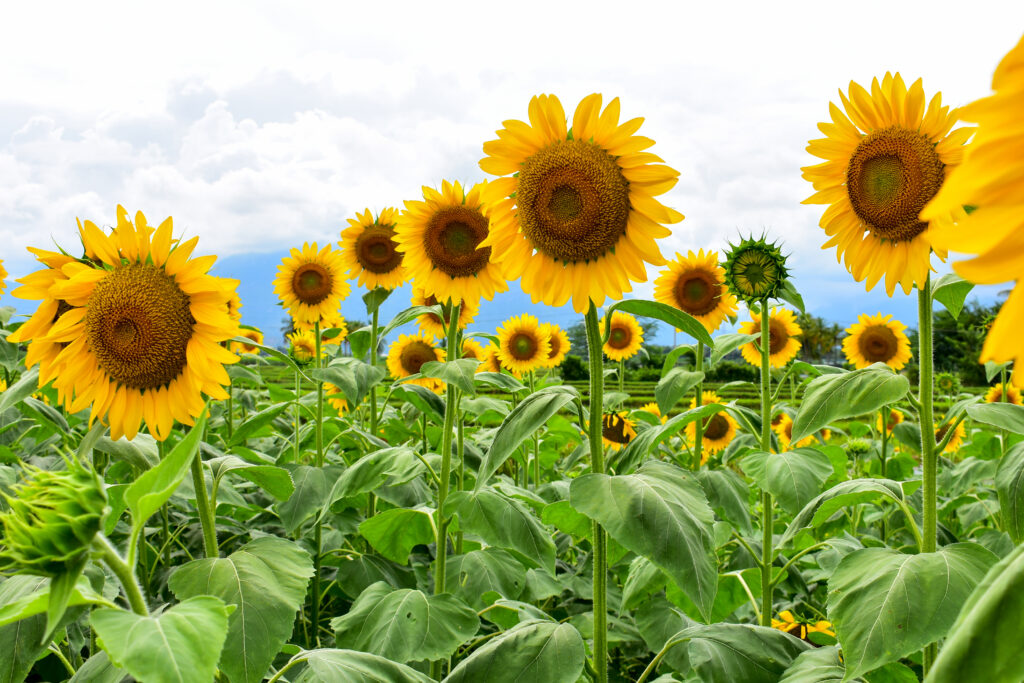
Sunflowers are a popular autumn flower in North America.
©Ganeshkumar Durai/Shutterstock.com
22. Witch Hazel
Native to North America, Witch Hazel prefers well-drained soil and can thrive in full sun to partial shade. This plant blooms from late fall into winter. Its spider-like yellow flowers appear when most other plants are dormant. The timing of its fragrant blossoms and its resilience to cold weather make Witch Hazel a marvel of the winter garden and secondary to an autumn garden.
23. Beautyberry
Hailing from East Asia and the American South, Beautyberries prefer full sun to partial shade and moist, well-drained soil. While their pinkish-white flowers in the summer are charming, the real show starts in late summer to autumn. Clusters of vibrant, jewel-like purple berries wrap around their branches, giving the Beautyberry its name.
24. Pansy
Originating from the Northern Hemisphere’s temperate regions, Pansies love cool weather and well-drained, rich soil. Moreover, they display their vibrant, often multicolored flowers from spring into early summer and again in fall. The unique pattern on their petals has often been compared to a human face, lending a playful charm to any garden.
25. Sweet Alyssum
This charming little flower from the Mediterranean loves a sunny location and well-drained soil. From spring until the first frost, it presents a carpet of tiny, sweet-smelling flowers in white, pink, or purple shades. The Sweet Alyssum is a delightful ground cover or border plant, spreading its honey-scented blooms throughout the garden.
26. Lungwort
Lungwort originates from Europe and Western Asia and thrives in shaded locations with well-drained, moist soil. This woodland plant blooms from late winter into spring, showcasing clusters of bell-shaped flowers that change from pink to blue as they mature. In addition, its silver-spotted leaves remain attractive long after the flowers fade, adding interest to the garden.
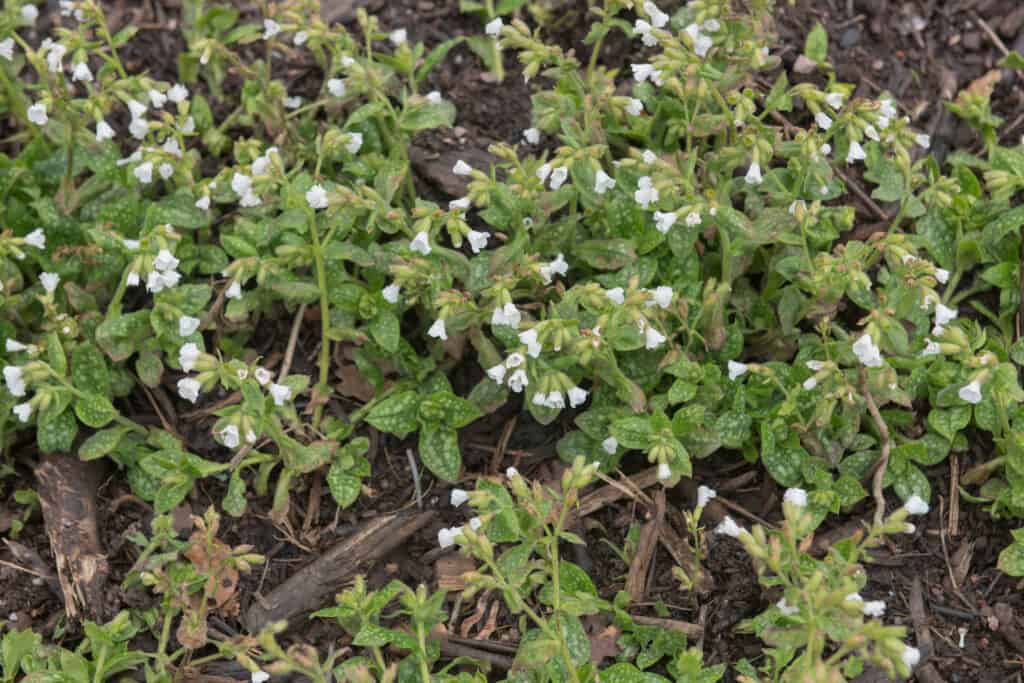
Lungwort is a bell-shaped flower that changes from pink to blue as they mature.
©Peter Turner Photography/Shutterstock.com
27. Fountain Grass
Native to warm, tropical regions, Fountain Grass thrives in full sun and well-drained soil. Its graceful, arching stems form a fountain-like clump, hence the name. From late summer to fall, the plant displays fluffy, bottlebrush-like flowers that sway with the breeze, adding movement and texture to the garden.
28. Begonia
Originating from tropical and subtropical regions, Begonias prefer well-drained soil, partial shade, and high humidity. Moreover, they can bloom from mid-summer to fall, showcasing a range of colors from white to red, pink, and yellow. The beauty of Begonias extends to their foliage, with some varieties featuring beautifully patterned leaves.
29. Balloon Flower
The Balloon Flower, native to East Asia, prefers full sun to part shade and well-drained soil. It blooms from summer to early fall, presenting blue, white, or pink star-shaped flowers. Finally, these blooms begin as balloon-shaped buds, lending the plant its whimsical name.
30. Blanket Flower
This North American native thrives in full sun and well-drained soil. It dazzles with bright red, yellow, or bi-colored daisy-like flowers from early summer to fall. Moreover, it is named for the colorful blankets made by Native Americans. Blanket Flowers add a vibrant, warm touch to any garden.
31. Mexican Bush Sage
Native to the highlands of Mexico, this hardy plant enjoys full sun and well-drained soil. From late summer into fall, it boasts long, velvety spikes of purple and white flowers. Additionally, its striking blooms, contrasted against silvery-green foliage, make Mexican Bush Sage an autumn standout.
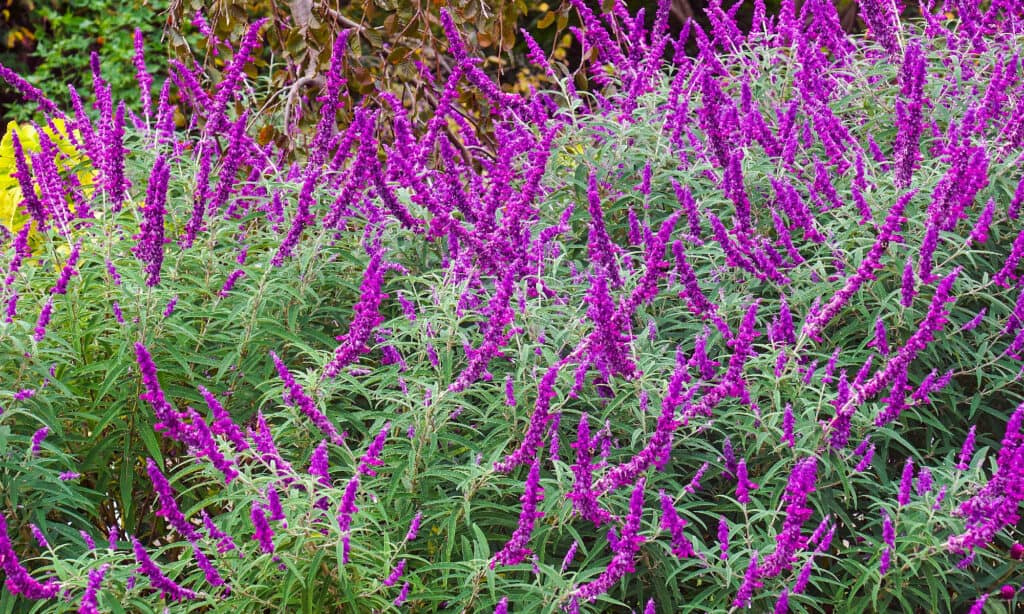
The Mexican bush sage has striking blooms contrasted against silvery-green foliage.
©Beach Creatives/Shutterstock.com
Conclusion
Autumn may mark the end of summer, but it’s far from the finale in the botanical world. Gardens and landscapes across the globe come alive with a vibrant palette of colors, textures, and scents, featuring a stunning array of autumn-blooming flowers that lend the land they reside in a unique aesthetic.
Fall Flowers From Around the World
Furthermore, one can enjoy the fiery hues of Helenium and Blanket Flowers. Both North American natives, they are perfect embodiments of the warm, earthy tones of fall. From mid-summer to autumn, the Helenium flower lights up the garden with its daisy-like blooms in shades of yellow, orange, and red. The Blanket Flower offers a similar visual spectacle, painting the landscape with bright red, yellow, and bi-colored daisy-like blossoms from early summer to fall.
Moreover, the enchanting Colchicum and Balloon Flower delight with their unique floral presentations. Colchicum, native to West Asia and the Mediterranean, bursts into bloom in the fall, showcasing large, goblet-shaped, pink-purple flowers that are a sight to behold. The Balloon Flower, an East Asian native, gets its name from the balloon-shaped buds that open to reveal star-shaped flowers from summer to early fall.
Mexican Bush Sage and Fountain Grass bring texture to the garden. Native to Mexico, the Mexican Bush Sage presents long, velvety spikes of purple and white flowers against silvery-green foliage, standing out in the autumn landscape. Fountain Grass, with its graceful, arching stems and fluffy, bottlebrush-like flowers, adds a sense of movement to the garden, especially from late summer to fall.
Meanwhile, plants like Witch Hazel and Sweet Alyssum add a delightful fragrance. Native to North America, Witch Hazel blooms from late fall into winter, releasing a pleasant scent from its spider-like yellow flowers. The Mediterranean Sweet Alyssum showcases a carpet of tiny, honey-scented flowers from spring until the first frost.
Fall Flowers Are Filled With Vibrancy and Abundance
Regardless of where they originate or their preferred conditions, these autumn flowers prove that the gardening season isn’t over when summer fades. They provide vibrant colors, intriguing textures, and aromatic delights, ensuring the garden remains a haven for humans and wildlife well into the cooler months. With careful selection considering where the plants are native to, and proper care, gardeners can enjoy a glorious floral display that extends the joy of gardening and landscaping throughout the fall season.
Thank you for reading! Have some feedback for us? Contact the AZ Animals editorial team.

